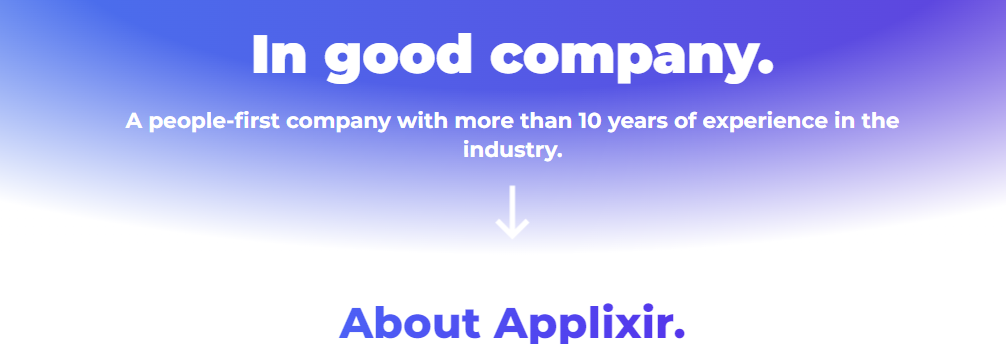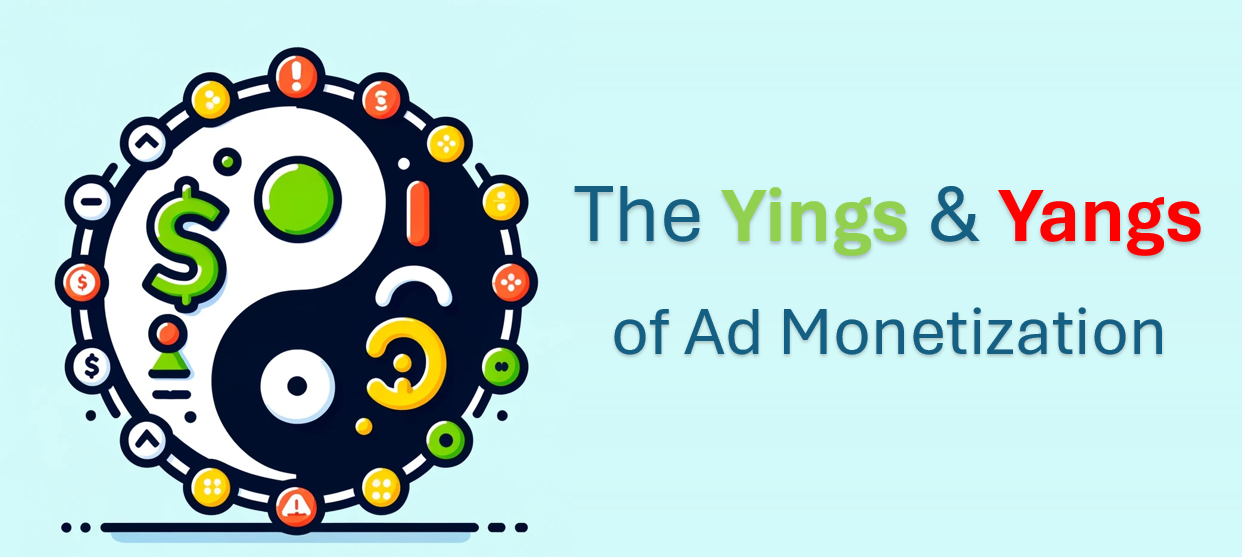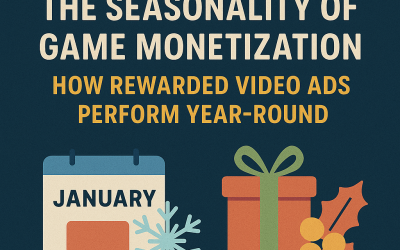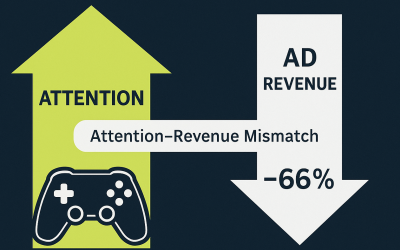The Yings and Yangs of Ad Monetization
Contents
Introduction

The effectiveness of ad monetization hinges on several factors, including the quality and relevance of the ads, the engagement level of the audience, and the placement and format of ads within the digital property. For advertisers, this model offers a valuable opportunity to reach potential customers within a targeted context, enhancing the likelihood of ad engagement. For publishers, it represents a critical strategy to capitalize on their content and user base, turning views and interactions into sustainable revenue streams. This symbiotic relationship between publishers and advertisers drives the continual evolution and sophistication of ad monetization strategies and technologies.
In this post, I will try to layout the various pros and cons of Ad Monetization. Remember, Ad monetization is the process by which digital content creators, app developers, and website owners generate revenue. This model leverages the traffic or user base of these digital properties to serve ads, which can range from display banners and video ads to interactive and native ads, tailored to the content or the user experience. Publishers earn income through various models such as cost per thousand impressions (CPM), cost per click (CPC), or cost per action (CPA), depending on the advertiser’s campaign objectives and the agreement with the ad network or platform.
Here is the general layout of my post
[ez-toc]
What is Ad Monetization
Monetization, in simple terms, is like turning your favorite hobby or skill into a money-making adventure. Imagine you love painting, and one day you decide to sell your artwork. The moment someone buys your painting, you’ve monetized your talent. In the digital world, this concept isn’t much different. If you run a blog, a YouTube channel, or develop mobile games, monetization is the process of earning money from your creations. It’s like setting up a lemonade stand in your front yard; instead of lemonade, you’re offering content, entertainment, or any digital product, and in return, you receive money from ads, subscriptions, or direct sales.
Ad monetization brings a dual-edged sword to the digital landscape. On the bright side, it offers creators, developers, and publishers a viable way to generate revenue from their content or services, enabling them to focus on producing more quality work and enhancing user experience. It democratizes income opportunities, allowing even small players to earn from their online presence. However, the flip side includes potential pitfalls like deteriorating user experience due to intrusive ads, reliance on fluctuating ad revenue, and navigating the complex world of user data privacy and regulatory compliance. Balancing these aspects is key to harnessing ad monetization’s full potential without alienating the audience it seeks to engage.
Below are some more details on the benefits (Yings) and disadvantages (Yangs) of Ad Monetization
 The Yings of Ad Monetization
The Yings of Ad Monetization
-
Expanding Revenue Streams
Ad monetization introduces an supplemental revenue channel, complementing subscriptions or direct sales. It incorporates diverse models like CPM, CPC, and CPA, each fitting different content and audience types. This flexibility enables publishers to maximize earnings based on their unique traffic patterns and user engagement metrics.
-
Enhancing User Engagement
Rewarded video ads and incentivized ads stand out for enhancing user experience. These models reward users for their engagement, such as accessing premium content or earning in-game items. This approach not only boosts user satisfaction but also fosters a positive perception of ads.
-
Accessibility and Scalability
Today, ad platforms cater to publishers of all sizes, making monetization accessible to everyone. The scalability of ad revenue is significant; as a site or app grows, so does its potential to generate income, making ad monetization a lucrative option for long-term growth.
-
Data Insights and Optimization
Ad platforms offer valuable insights into user behavior and engagement. Publishers can leverage this data to fine-tune content and ad placements, optimizing both user experience and revenue generation.
The Yangs of Ad Monetization
-
User Experience Concerns
Intrusive ads can deter users, leading to higher bounce rates or app uninstalls. The rise of ad blockers further complicates revenue generation, prompting a need for balance between ad visibility and user experience.
-
Revenue Dependence and Instability
Ad revenue can fluctuate based on market trends, seasonal changes, and advertiser budgets. This volatility requires publishers to strategize for stability, often diversifying their monetization methods to mitigate risks.
-
Privacy and Regulatory Challenges
The digital ad space is increasingly scrutinized for privacy concerns. Regulations like GDPR and CCPA necessitate compliance, impacting how ads are targeted and, consequently, their effectiveness. Navigating these regulations is crucial for sustaining ad revenue.
-
Technical Integration and Maintenance
Integrating ad SDKs and platforms can pose technical challenges. Ensuring seamless ad delivery while maintaining app or website performance requires ongoing attention and updates, demanding resources from publishers.
Best Practices for Balancing the Yings and Yangs
Continuing on The Yings and Yangs of Ad Monetization post, navigating the complexities of ad monetization successfully requires a nuanced approach that respects both the user’s experience and the need for revenue generation. Here’s an expanded look at the best practices for achieving this balance:
-
Opt for Non-Intrusive Ad Formats:
The key to maintaining a positive user experience while displaying ads is to integrate them seamlessly into your content. This could mean using native ads that mimic the look and feel of your platform’s content or opting for unobtrusive banner ads placed strategically so they don’t interrupt user engagement. Video ads, particularly rewarded ones, offer value to the user and can be an effective way to keep ads from feeling invasive. The goal is to make ads as natural and less distracting as possible, enhancing rather than detracting from the user experience.
-
Prioritize User Consent:
With growing concerns around privacy and data protection worldwide, it’s critical to transparently manage user data. This involves clearly communicating what data you collect and how it’s used, and ensuring users have easy options to control their data preferences. Implementing straightforward consent mechanisms not only complies with regulations like GDPR and CCPA but also fosters a trust-based relationship with your audience. Trust is a cornerstone of user loyalty, which, in turn, can lead to better engagement rates and a more receptive attitude towards ads.
-
Leverage Analytics and A/B Testing:
Understanding what works and what doesn’t is essential for optimizing ad monetization strategies. By analyzing user interaction with ads and employing A/B testing to compare different ad formats and placements, publishers can identify the most effective combinations. This data-driven approach allows for the fine-tuning of ad strategies to maximize revenue without compromising the user experience. For instance, analytics might reveal that users engage more with video ads at a specific point within content, guiding a strategy to place ads where they perform best.
-
Diversify Monetization Strategies:
Relying solely on ad revenue can be risky due to its variability. To mitigate this, publishers should explore and implement a mix of monetization strategies. Subscriptions offer a steady revenue stream, appealing to users who prefer an ad-free experience. Affiliate marketing, where publishers earn commissions for referring products or services, can complement ad revenues without overwhelming users with ads. Additionally, offering premium content or features for a fee can attract users willing to pay for added value. This diversification not only stabilizes income but also caters to different user preferences, enhancing overall engagement and loyalty.
AppLixir Ad Monetization
Before I end up my post on The Yings and Yangs of Ad Monetization post, by adopting a strategic approach that values user experience and leverages data insights, publishers can navigate these waters successfully. Balancing the yings and yangs of ad monetization not only maximizes revenue potential but also ensures sustainability in the ever-evolving digital ecosystem. AppLixir is a leader in Rewarded Video Ad Monetization and welcome any question or suggestion in the space! Read out latest post on how much you could make with Rewarded Video Ad in 2024!




